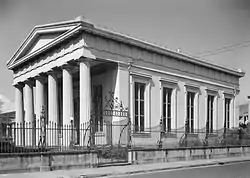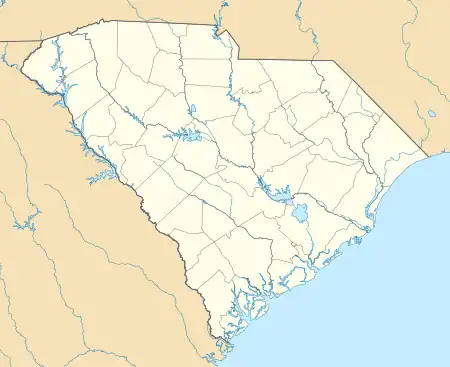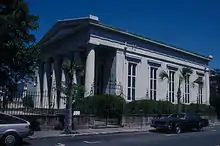Kahal Kadosh Beth Elohim
Kahal Kadosh Beth Elohim (Hebrew: קהל קדוש בית אלוהים, also known as K. K. Beth Elohim, or more simply Congregation Beth Elohim) is a Reform Synagogue located in Charleston, South Carolina. Having founded the congregation in 1749, it was later claimed to be the first Reform synagogue located in the United States,[3] the current 1841 synagogue was built by enslaved African descendants owned by David Lopez Jr, a prominent slaveowner and proponent of the Confederate States of America, after the original synagogue was destroyed in a fire in 1838. It is one of the oldest Jewish congregations in the United States.[4] The congregation is nationally significant as the place where ideas resembling Reform Judaism were first evinced. It meets in an architecturally significant 1840 Greek Revival synagogue located at 90 Hasell (pronounced as if it were spelled Hazel) Street in Charleston, South Carolina. It was designed by Cyrus L. Warner.
Kahal Kadosh Beth Elohim Synagogue | |
 Kahal Kadosh Beth Elohim | |
  | |
| Location | 90 Hasell St., Charleston, South Carolina |
|---|---|
| Coordinates | 32°46′56″N 79°55′58″W |
| Built | Founded in the 1749; current sanctuary built in 1840 |
| Architect | Cyrus L. Warner; David L. Lopez |
| Architectural style | Greek Revival |
| NRHP reference No. | 78002499 |
| Significant dates | |
| Added to NRHP | April 4, 1978[1] |
| Designated NHL | June 19, 1980[2] |
History
Before 1830 Kahal Kodesh Beth Elohim (KKBE) was a place of worship in Charleston, South Carolina for Spanish and Portuguese Jews using Portuguese rituals as done in Portugal before the Spanish and Portuguese inquisitions, it later adopted a reformed religious ritual, after reabsorbing a splinter group originally led by Isaac Harby. In 1824 the Reformed Society of the Israelites was founded by Portuguese Jews. It adopted ideas from the European Reform movement, and itself contributed ideas to the later, widespread American Reform movement, but was also quite different form either of them, with its own unique Reform prayer-book, the first in America.[5]
The founding members of the KKBE were Sephardi Jews of Spanish and Portuguese, who arrived into Charleston from London, England to work in mercantile freight and the slave trade.[6] While the congregation is sometimes considered to be the originator of Reform Judaism in the United States, that movement was established by European immigrants mostly from Germany later on.
Rabbi Burton Padoll, who served as the synagogue's rabbi during the 1960s, was an outspoken activist for the rights of African-Americans. Rabbi Padoll was forced to resign as rabbi after prominent members of the congregation objected to his support for the civil rights movement.[7]
Synagogue

The present Greek Revival building is the second oldest synagogue building, and the oldest in continuous use, in the United States;[8] in addition, it has the oldest continually operating Jewish cemetery in the United States.[9] It is a single story brick building, set on a raised granite foundation. The brick is stuccoed and painted white, and is marked in manner to resemble stone blocks. The front has a full Greek temple front, with fluted Doric columns supporting a gabled pediment.[10] The building was added to the National Register of Historic Places on April 4, 1978, as Kahal Kadosh Beth Elohim Synagogue[1] and was designated a National Historic Landmark on June 19, 1980.[2][10] The Coming Street Cemetery, owned by the Congregation, is listed separately on the National Register of Historic Places.

In 2021, a monument was installed with an inscription at the site of the synagogue, to commemorate the forced human labor extracted from Black Africans owned by industrialist and slaveowner David Lopez Jr in the construction of the site; In acknowledging the past injustice, Rabbi Stephanie Alexander says "We're being honest and transparent about what has enabled us to come together and has enabled us to come to this space."[11]
Inside the synagogue, there is a mural which includes a Jewish Confederate soldier sitting with a broken sword, an artistic depiction of the Lost Cause of the Confederacy.[12]
See also
References
- "National Register Information System". National Register of Historic Places. National Park Service. January 23, 2007.
- "Kahal Kadosh Beth Elohim". National Historic Landmark summary listing. National Park Service. Archived from the original on June 6, 2011. Retrieved March 3, 2008.
- "Kahal Kadosh Beth Elohim Synagogue". National Park Service. US Department of the Interior. Retrieved February 8, 2022.
- Jonathan Sarna. American Judaism: A History, Yale University Press, 2004, p. 19.
- Harby, Isaac; Moise, Abraham; Carvalho, D. N., eds. (1830). The Sabbath Service and Miscellaneous Prayers, Adopted by the Reformed Society of Israelites, founded in Charleston, S. C., November 21, 1825. Reprinted with an introduction by Dr. Barnett A. Elzas (Block Publishing Company, New York, 1916 ed.). 44 Queen St., Charleston (SC): J.S. Burges.
(From the Editor's Preface:) The Charleston Movement of 1824 was not an indigenous movement, but directly dependent upon a similar movement that had taken place in Germany a few years before, now popularly known as the Hamburg Movement. The Prayer Book of the Reformed Society of Israelites however has nothing in common with the one published for the use of the Hamburg Temple in 1819. Apart from its novelties such as the Articles of Faith, the Wedding Service, the Confirmation Service, the Service for Circumcision and for Naming a Daughter and its English Hymns, it is based upon the Portuguese Ritual then in use in Charleston.
{{cite book}}: CS1 maint: location (link) - Stiefel, Barry (2012). "David Lopez Jr.: Builder, Industrialist, and Defender of the Confederacy". American Jewish Archives Journal. Retrieved February 8, 2022.
- "Don't Whitewash Charleston's Jewish History of Racism". The Forward. June 22, 2015. Retrieved August 29, 2018.
- Gordon, Mark W. "Rediscovering Jewish Infrastructure: 2022 Update on United States Eighteenth and Nineteenth-Century Synagogues", American Jewish Historical Society, November 4, 2021. Accessed February 22, 2023.
- "Kahal Kadosh Beth Elohim Synagogue, Charleston County (90 Hasell St., Charleston)". National Register Properties in South Carolina listing. South Carolina Department of Archives and History. Retrieved March 23, 2008.
- Polly Ann Matherly (April 1980). "National Register of Historic Places Inventory-Nomination: Kahal Kadosh Beth Elohim; Congregation Beth Elohim; Beth Elohim Synagogue" (pdf). National Park Service.
{{cite journal}}: Cite journal requires|journal=(help) and Accompanying three photos, exterior and interior, from 1973 and 1977 (32 KB) - Ciapha Dennis Jr, Rickey (September 13, 2021). "SC Synagogue Remembers Enslaved Black People Who Built It". NPR. South Carolina Public Radio. Retrieved February 8, 2022.
- "Pocket Guide to Kahal Kadosh Beth Elohim and Charleston Jewish History" (PDF). Jewish Historical Society of South Carolina. Retrieved April 23, 2022.
External links
- Kahal Kadosh Beth Elohim website
- Jewish Historical Society of South Carolina website
- Kahal Kadosh Beth Elohim Synagogue, Charleston County (90 Hasell St., Charleston), at South Carolina Department of Archives and History
- Historic Charleston's Religious and Community Buildings, a National Park Service Discover Our Shared Heritage Travel Itinerary

